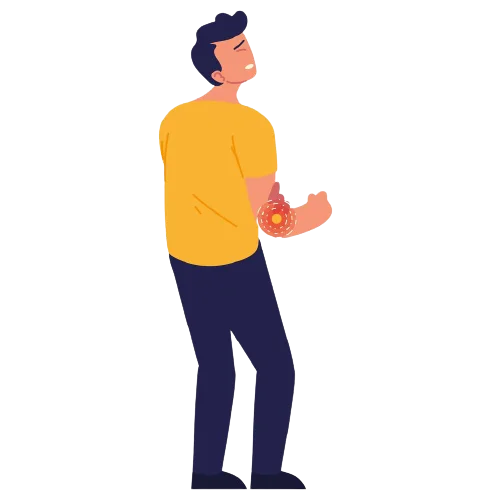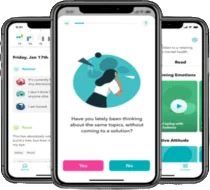Elbow pain treatment online | Online Physiotherapy Clinic
- Affordable and reliable Elbow pain treatment
- Video sessions with expert Physiotherapists/ PTs.
- Specialized physical therapy for Elbow pain, sprain, bursitis, or stiffness
Begin Therapy
Consult online with best Physios
A New Model for Elbow Pain Treatment
We understand that it’s difficult for most of us to find time for traditional Elbow physical therapy. PhysioMantra brings to you online Elbow pain treatment, where all Elbow exercises and treatments are managed through regular online check-ins & video sessions.
Expert Physical therapists
Physio Mantra members get matched with a professional physiotherapist for one-on-one Elbow pain treatment. They use interactive exercise videos available on our app to treat you.
Continuous Medical Care
Physio Mantra physiotherapists are 100% virtual and provide physical therapy to patients without any time and geographical barriers. Our technology-enabled approach helps manage physical ailments from head to toe.
Personalized Elbow Pain therapy
Physio Mantra provides everyday exercises, home remedies, and regular check-ins for all your Elbow pain physiotherapy needs. We individualize treatment for each person, with problems including Elbow pain, muscle injuries, sprain, bursitis, stiffness, and more.

Best Elbow Pain Clinic, Now In Your Pocket
Our physical therapists or PTs are available in all parts of the world via an easy-to-use mobile application. The use of artificial intelligence, and data science enables the patients to connect with expert physiotherapists and get real-time insights into their Elbow health. Download PhysioMantra App Now

How it works

Signup for our Elbow Treatment Program
Just fill up a 5-minute online form to tell us about your Elbow pain history and treatment expectations.

Meet your PT
We will connect you with a physiotherapist who is available 24/7 to you via call or chat.

Connect to our app
Get Physical Therapy sessions on our app via video calls. Follow exercises suggested by our PT and track your progress in the app.
Meet the best online physical therapist
MantraCare physical therapists treat muscle and joint pain problems through a combination of body exercises, video demonstrations, and a healthy diet. Our treatment experience is a better traditional in-person approach in multiple ways.

Dedicated Physio
You get a personal Physio who customizes the exercise plan based on your comfort and needs

App-guided Exercises
3D animations & voice narrations in our app ensure proper and right guidance

Expert care anywhere, anytime
With over 200+ physios, MantraCare is 100% online – no waiting rooms

Exercise Kit
Complete exercise kit with elastic bands, door anchor, and a phone stand – mailed to you
A Complete Guide On Elbow Pain Physiotherapy
Understanding Elbow Pain
Elbow pain is a common form of joint pain that has many causes. It can be caused by something as simple as sleeping in an awkward position or as serious as arthritis and other diseases.
This kind of pain can be felt in the elbow joint itself or along the arm. It may be a sharp, stabbing pain, a dull ache, or something that feels like it’s burning. The pain can also vary depending on what activity you are doing when it flares up.
Sometimes, elbow pain is accompanied by redness, swelling, or tenderness. You might also experience stiffness in the joints and a limited range of motion when you bend your arm. In some cases, it can be difficult to move your arm at all.
The causes for this type of joint pain are varied but can usually be traced back to an injury that occurred during physical activity or daily life. One common cause is tennis elbow (also called lateral epicondylitis), which occurs from repetitive use of the wrist and forearm extensor muscles over time.
Types of Elbow Pain
There are many types of elbow pain, each with its own unique set of symptoms.
Elbow Bursitis
This condition is caused by inflammation of the bursa, a small fluid-filled sac that acts as a cushion between bones and muscles. The bursa can become inflamed from overuse or an injury, resulting in pain and swelling around the elbow joint. This type of pain is most common in athletes who play sports like baseball and tennis.
Tennis Elbow (Lateral Epicondylitis)
This type of elbow pain is caused by inflammation at the outside part of your elbow, known as the lateral epicondyle. It’s often associated with repetitive wrist movements, such as those used in playing racquetball or other racket sports. It can also be caused by activities that require grasping and twisting, like using a screwdriver.
Golfers Elbow (Medial Epicondylitis)
This type of elbow pain is the result of inflammation at the inside part of your elbow, which is called the medial epicondyle. It’s most commonly seen in people who play golf or other sports that involve swinging a club. The condition can also develop from repetitive use of the hand and fingers, such as typing on a keyboard.
Ulnar Nerve Entrapment
The ulnar nerve travels down the arm to the hand and can become compressed or entrapped if there’s swelling or inflammation around it. This can cause pain, tingling, and numbness in the hand, fingers, and thumb. Activities that put pressure on the nerve, like sleeping on your arm or carrying a heavy bag, can make the symptoms worse.
Infection
An infection around the elbow can cause a range of symptoms ranging from mild to severe. The infection may be caused by a virus, bacteria, or fungus and can develop after an injury or surgery. Symptoms can include pain, swelling, redness, warmth, and drainage from the elbow.
Signs of Elbow Pain
There are many different signs of elbow pain, depending on the cause. Some common symptoms include:
- Pain in your elbow or forearm
- Swelling around your joint
- Redness and warmth near where it hurts
- Weakness when moving your wrist up and down or side to side (like a weak handshake)
- Feeling like something is stuck in there with no way out (called “frozen”)
- feeling of tingling or numbness in your hand and fingers
- Difficulty moving your arm, especially bending it
- Joint stiffness
- A popping or cracking sound when you move your elbow.
Causes of Elbow Pain
There are many different causes of elbow pain, some more common than others. The most common causes are:
Injury – an accident or sudden impact can cause damage to the tissues around your elbow joint, leading to inflammation and pain. This is most often seen in athletes who play contact sports.
Overuse – using your arm and elbow muscles over time can lead to inflammation and pain. This is a common problem for people who do repetitive tasks with their arms, like typing on a keyboard or playing tennis.
Arthritis – there are several types of arthritis that can affect the elbow, causing pain, swelling, and stiffness in the joint.
Gout – this type of arthritis is caused by high levels of uric acid in the blood. It can cause sudden, severe pain in one joint (usually the big toe) due to crystals forming inside of it.
Infection – an infection around your elbow can lead to swelling and pain, as well as redness or warmth in the area. This is most commonly seen with bacterial infections like staphylococcus aureus (MRSA) or streptococcus pyogenes (strep throat).
Cancer – cancerous tumors in the bones surrounding your elbow may cause pain if they grow large enough that they press on nearby nerves or blood vessels. These types of tumors are rare but should be considered when other causes have been ruled out by your doctor through diagnostic testing such as an X-ray or MRI.
Treatment Options For Elbow Pain
The treatment for elbow pain will depend on what is causing it. Some common treatments include:
Physical Therapy
If you are experiencing overuse or arthritis-related elbow pain, physical therapy may be recommended. A physical therapist can teach you exercises to stretch and strengthen the muscles around your elbow joint, which will help to relieve pain and improve function.
Rest
This is the most important thing you can do to help your elbow heal. Your doctor may recommend that you stop using your arm for a period of time or only use it at certain times each day so that it can rest and recover from any injury or overuse. You should also avoid activities like typing, writing, playing sports.
Anti-inflammatory Drugs
Nonsteroidal anti-inflammatory drugs (NSAIDs) like ibuprofen, naproxen, and celecoxib can help to reduce inflammation and pain.
Surgery
In some cases, surgery may be necessary to repair damage to the tissues around your elbow joint caused by an injury or infection. Your doctor will discuss all of the treatment options with you and make a recommendation based on your individual situation.+-
Physiotherapy For Elbow Pain
Physiotherapy is a treatment that uses exercises, stretching, and other techniques to help relieve muscle pain. It can also be used in conjunction with other treatments such as physical therapy or rest.
Physiotherapy is designed to improve function by strengthening the muscles around your elbow joint so they are less likely to become injured again in the future. These exercises will also increase blood flow which brings nutrients into hard-working tissues like tendons, ligaments, cartilage etcetera and takes away harmful waste products from them at the same time (which increases their recovery time).
Your physiotherapist may recommend some specific equipment for use during these sessions such as an exercise ball or bands so ask about what’s included when booking your appointment.
Types of Physiotherapy For Elbow Pain
There are many different types of physiotherapy that can be used to treat elbow pain. Some common treatments include:
Manual Therapy
This type of therapy uses the hands to help move and stretch your muscles. It may also involve massage techniques which can help to relieve tension and improve blood flow.
Heat/Ice Packs
Applying heat or ice packs to the area can help reduce inflammation and pain. Make sure not to apply them directly on the skin because it could cause a skin injury.
TENS (Transcutaneous Electrical Nerve Stimulation)
This is a treatment that uses an electrical current to stimulate the nerves around your elbow joint. This may help to reduce pain and inflammation.
Ultrasound
Ultrasound is a form of therapy that uses sound waves to stimulate the muscles and tendons around your elbow joint. It may help relieve pain and improve range of motion as well.
Elbow Pain Exercises
The exercises below can help strengthen the muscles around your elbow joint so they’re less likely to become injured again in the future.
Benefits of Physiotherapy For Elbow Pain
There are many benefits to physiotherapy for elbow pain. Some of these benefits include:
Reliefs From Pain and Inflammation
This treatment can help relieve pain and inflammation in your elbow joint so you’re able to move it more easily, which will also reduce stiffness.
Improve Range of Motion
Physiotherapy can improve the range of motion by strengthening the muscles around your elbow joint. This means they won’t become as tight or stiff when doing daily activities such as lifting objects from the ground without causing any damage to them over time (and eventually leading up to future problems).
Increase Functionality and Quality of Life
This treatment improves functionality, which means that people who have had an injury are able to do things like return work or participate in sports again after recovering from their injury with physiotherapy for elbow pain. It also increases the quality of life as people are now able to do the things they love without having any restrictions.
10,000+ Happy Elbow Pain patients from the world

“From the opening staff to the physiotherapists themselves, they are all professional, competent, and caring. This is a splendid physio center where the patient is always put first. Nothing is ever too much trouble. I would highly recommend them to anyone in need of physio treatment.”
Kamya, 3 Months at MantraCare
Best physiotherapist from across the world





We treat nearly all muscle and joint issues
Not all physical or muscle problems are the same. Different types of problems require different treatments. At MantraCare, 200+ physical therapist the world cover a range of specialties to meet your needs be it back pain, shoulder pain, or sports injury:
Frequently Asked Questions
This question can be difficult to answer as it depends on each individual’s situation. However, your physiotherapist will be able to give you a good estimate based on your specific condition.
Most health insurance companies do cover physiotherapy treatments; however, it’s always best to check with your provider beforehand.
There are many different ways that you can receive physiotherapy treatments whether you live near a physio clinic or not. This includes treatments like ultrasound and TENS which can be done at home.
Yes, physiotherapy is a safe treatment for both children and adults. In fact, it’s often recommended that pediatricians refer children to physiotherapists to help with various conditions such as joint pain, asthma, and developmental delays. It’s important to note that not all treatments are suitable for children, so be sure to discuss this with your physiotherapist.
No, physiotherapy does not work for everyone. However, it is a safe and effective treatment option for many people with elbow pain. It’s important to discuss your individual situation with a physiotherapist in order to get the best treatment plan possible. You can fill this short physiotherapy questionnaire to book your free visit with a Physical Therapist.
Physiotherapy is a treatment that involves using different exercises and therapies to help improve the range of motion, reduce pain, and inflammation in the elbow joint. It’s often recommended for people who have recently injured their elbow or those who have chronic elbow pain.
Most health insurance companies do cover the cost of physiotherapy, but it’s always best to check with your provider. Sometimes, physiotherapy may be partially covered or you may need to pay a co-pay.
Yes, there are many different ways that you can receive physiotherapy treatments whether you live near a physio clinic or not. This includes treatments like ultrasound and TENS which can be done at home.
Your first physiotherapy session will involve discussing your condition and medical history with your therapist. You will then undergo a physical assessment where your therapist will test your range of motion, muscle strength, and joint stability. After this, you will begin your treatment plan which may include exercises or therapies like ultrasound or TENS.










